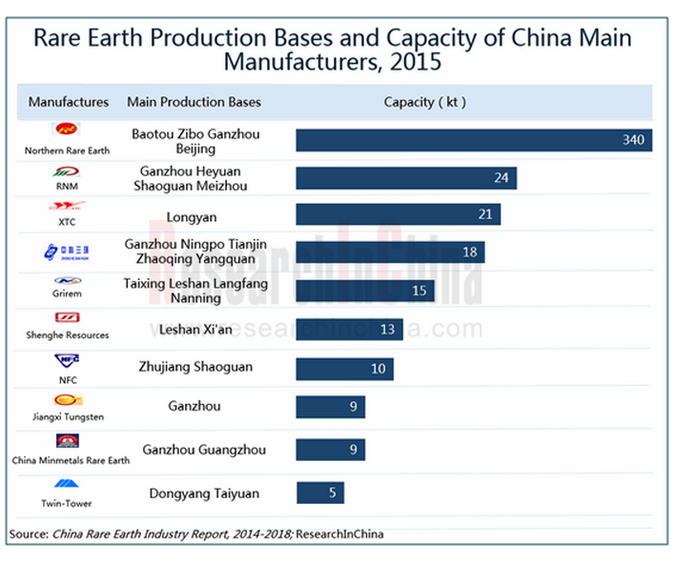
© wrangler dreamstime.com
General |
Rare Earths and China's dominance
At present, rare earth resources have been discovered in about 35 countries and regions around the world, with total reserves of 130 million tons, of which 42.3 percent are owned by China alone.
Rare earth, also known as rare earth metal or rare earth element, collectively refers to lanthanides (including fifteen elements) and closely-related scandium and yttrium. As a crucial strategic resource, it is mainly contained in bastnaesite, xenotime, monazite, and other minerals. At present, rare earth resources have been discovered in about 35 countries and regions around the world, with total reserves of 130 million tons, of which 42.3 percent are owned by China alone.
In order to protect and rationally develop superior resources, China has adopted a cap-control policy for rare earth exploitation since 2006 so that the rare earth ore production suffered a continuous decline from 2010 to 2013. In 2014, the State raised the upper limit, a move that helped drive the rare earth output rise 14.5 percent year on year to 95,000 tons, occupying about 86.4 percent of the global total.
Besides meeting the domestic demand, China’s rare earth and its products are also exported to the United States, Europe, Japan, South Korea, etc., with 2014’s export volume of rare earth products reaching about 29,000 tons (rare-earth permanent magnet products 75.5 percent), accounting for 32.1 percent of the total output. Despite a steady rise in rare earth product exports over the past two years, the export value, affected by the lower export prices, continued to fall, by 35.7 percent to USD370 million in 2014.
China’s rare earth industry has been facing quite a few challenges like low enterprise concentration and scattered layout. In 2014, Inner Mongolia Baotou Steel Rare-earth, which represents the largest market share, generated revenue that accounted for a meager 7.1 percent of the total nationwide. In 2015, the 6 major rare earth companies will implement integration, when the rare earth industry concentration will increase significantly.
 © Research in China
Inner Mongolia Baotou Steel Rare-earth (Group): As China's largest rare earth producer, the company has an annual capacity of approximately 350,000 tons/a. In April 2015, the company, along with the Department of Science and Technology of Inner Mongolia, Baotou Municipal Government, and Chinese Academy of Sciences (CAS), established CAS Baotou Rare Earth Research and Development Center, hoping to further enhance the research and development capabilities of rare earth application products.
Rising Nonferrous Metals Group: On May 30, 2015, the company proposed to raise a fund of RMB2.2 billion from targeted sources, of which RMB570 million will go into rare earth mine expansion: RMB390 million into Pingyuan Huaqi Rare Earth Industrial Co., Ltd., and RMB180 million into Dapu Xinchengji Industry & Trade Co., Ltd.
China Non-ferrous Metal Industry’s Foreign Engineering and Construction: In March 2014, the company began to develop Kvanefjeld rare earth project in cooperation with Greenland Minerals and Energy. In March 2015, the project’s feasibility research was completed and pilot operation can be carried out within the year.
Zhong Ke San Huan: As the largest NdFeB manufacturer in China, it now has the capacity of 14,000 tons/a sintered NdFeB and 1,500 tons/a bonded NdFeB. In February 2015, the company signed an agreement with Hitachi Metals over an attempt to set up a high-performance NdFeB joint venture in China, with a design capacity of 2,000 tons/a.
© Research in China
Inner Mongolia Baotou Steel Rare-earth (Group): As China's largest rare earth producer, the company has an annual capacity of approximately 350,000 tons/a. In April 2015, the company, along with the Department of Science and Technology of Inner Mongolia, Baotou Municipal Government, and Chinese Academy of Sciences (CAS), established CAS Baotou Rare Earth Research and Development Center, hoping to further enhance the research and development capabilities of rare earth application products.
Rising Nonferrous Metals Group: On May 30, 2015, the company proposed to raise a fund of RMB2.2 billion from targeted sources, of which RMB570 million will go into rare earth mine expansion: RMB390 million into Pingyuan Huaqi Rare Earth Industrial Co., Ltd., and RMB180 million into Dapu Xinchengji Industry & Trade Co., Ltd.
China Non-ferrous Metal Industry’s Foreign Engineering and Construction: In March 2014, the company began to develop Kvanefjeld rare earth project in cooperation with Greenland Minerals and Energy. In March 2015, the project’s feasibility research was completed and pilot operation can be carried out within the year.
Zhong Ke San Huan: As the largest NdFeB manufacturer in China, it now has the capacity of 14,000 tons/a sintered NdFeB and 1,500 tons/a bonded NdFeB. In February 2015, the company signed an agreement with Hitachi Metals over an attempt to set up a high-performance NdFeB joint venture in China, with a design capacity of 2,000 tons/a.
 © Research in China
Inner Mongolia Baotou Steel Rare-earth (Group): As China's largest rare earth producer, the company has an annual capacity of approximately 350,000 tons/a. In April 2015, the company, along with the Department of Science and Technology of Inner Mongolia, Baotou Municipal Government, and Chinese Academy of Sciences (CAS), established CAS Baotou Rare Earth Research and Development Center, hoping to further enhance the research and development capabilities of rare earth application products.
Rising Nonferrous Metals Group: On May 30, 2015, the company proposed to raise a fund of RMB2.2 billion from targeted sources, of which RMB570 million will go into rare earth mine expansion: RMB390 million into Pingyuan Huaqi Rare Earth Industrial Co., Ltd., and RMB180 million into Dapu Xinchengji Industry & Trade Co., Ltd.
China Non-ferrous Metal Industry’s Foreign Engineering and Construction: In March 2014, the company began to develop Kvanefjeld rare earth project in cooperation with Greenland Minerals and Energy. In March 2015, the project’s feasibility research was completed and pilot operation can be carried out within the year.
Zhong Ke San Huan: As the largest NdFeB manufacturer in China, it now has the capacity of 14,000 tons/a sintered NdFeB and 1,500 tons/a bonded NdFeB. In February 2015, the company signed an agreement with Hitachi Metals over an attempt to set up a high-performance NdFeB joint venture in China, with a design capacity of 2,000 tons/a.
© Research in China
Inner Mongolia Baotou Steel Rare-earth (Group): As China's largest rare earth producer, the company has an annual capacity of approximately 350,000 tons/a. In April 2015, the company, along with the Department of Science and Technology of Inner Mongolia, Baotou Municipal Government, and Chinese Academy of Sciences (CAS), established CAS Baotou Rare Earth Research and Development Center, hoping to further enhance the research and development capabilities of rare earth application products.
Rising Nonferrous Metals Group: On May 30, 2015, the company proposed to raise a fund of RMB2.2 billion from targeted sources, of which RMB570 million will go into rare earth mine expansion: RMB390 million into Pingyuan Huaqi Rare Earth Industrial Co., Ltd., and RMB180 million into Dapu Xinchengji Industry & Trade Co., Ltd.
China Non-ferrous Metal Industry’s Foreign Engineering and Construction: In March 2014, the company began to develop Kvanefjeld rare earth project in cooperation with Greenland Minerals and Energy. In March 2015, the project’s feasibility research was completed and pilot operation can be carried out within the year.
Zhong Ke San Huan: As the largest NdFeB manufacturer in China, it now has the capacity of 14,000 tons/a sintered NdFeB and 1,500 tons/a bonded NdFeB. In February 2015, the company signed an agreement with Hitachi Metals over an attempt to set up a high-performance NdFeB joint venture in China, with a design capacity of 2,000 tons/a.